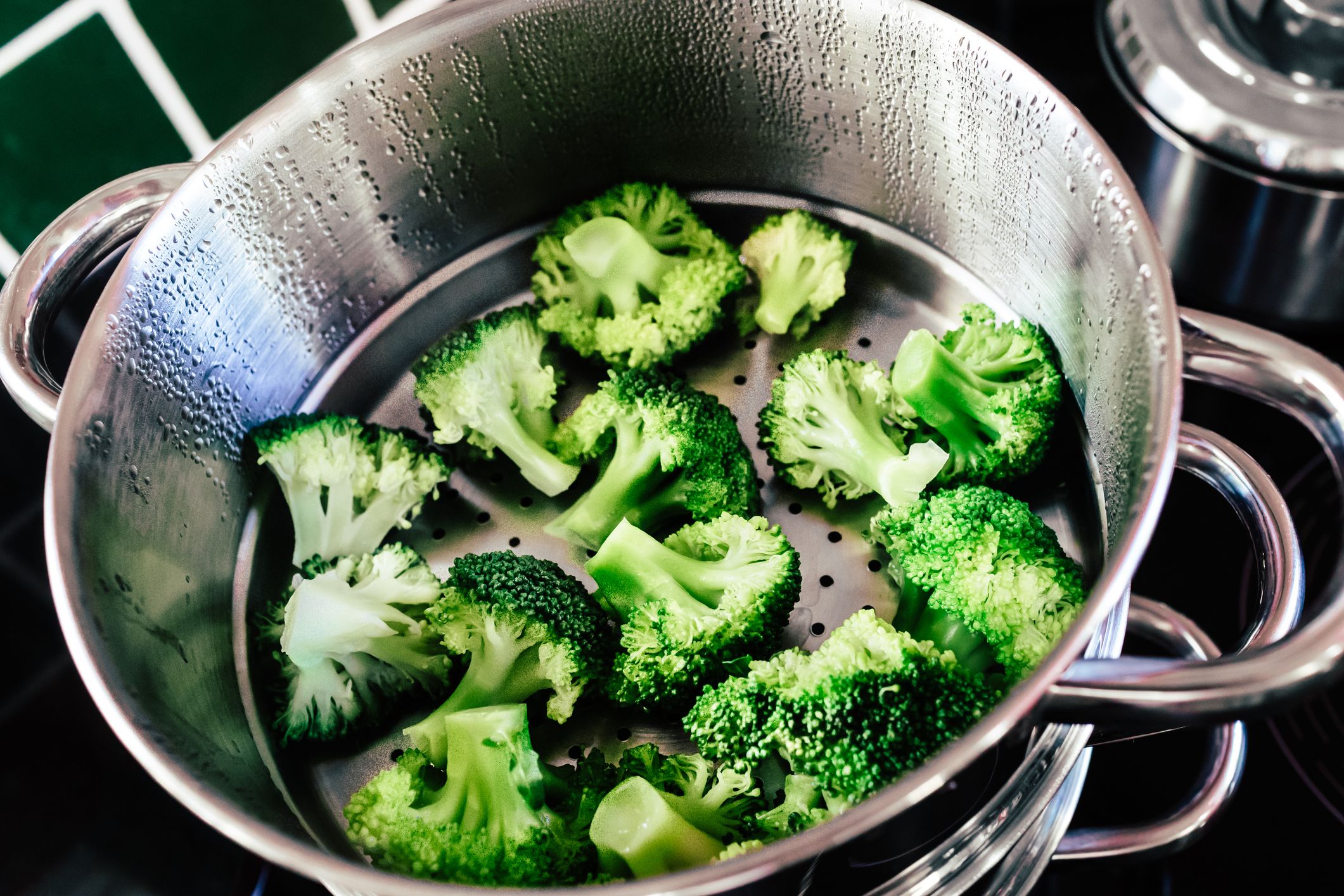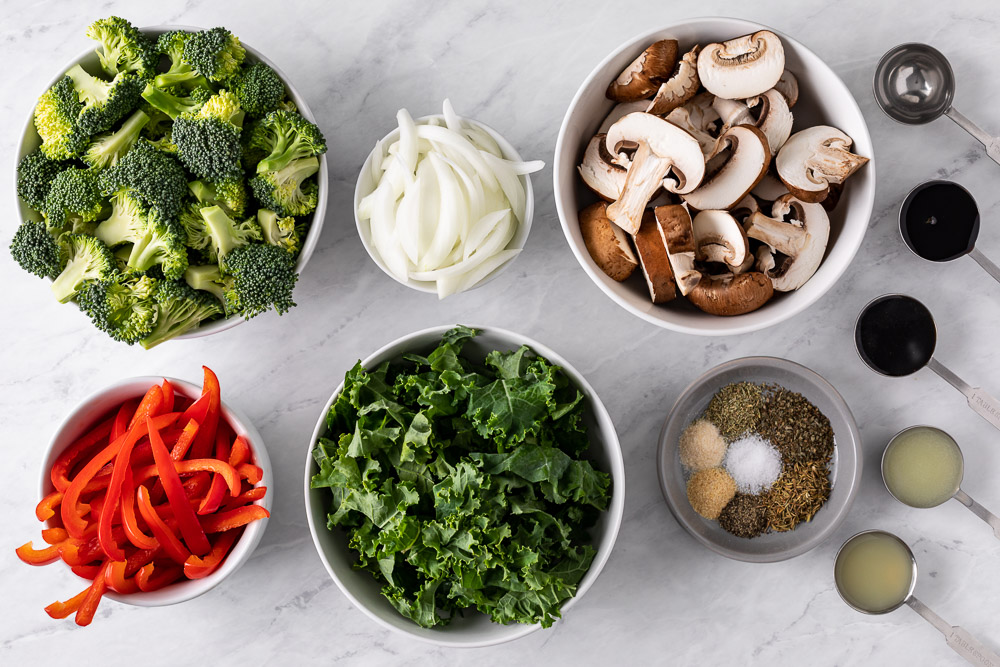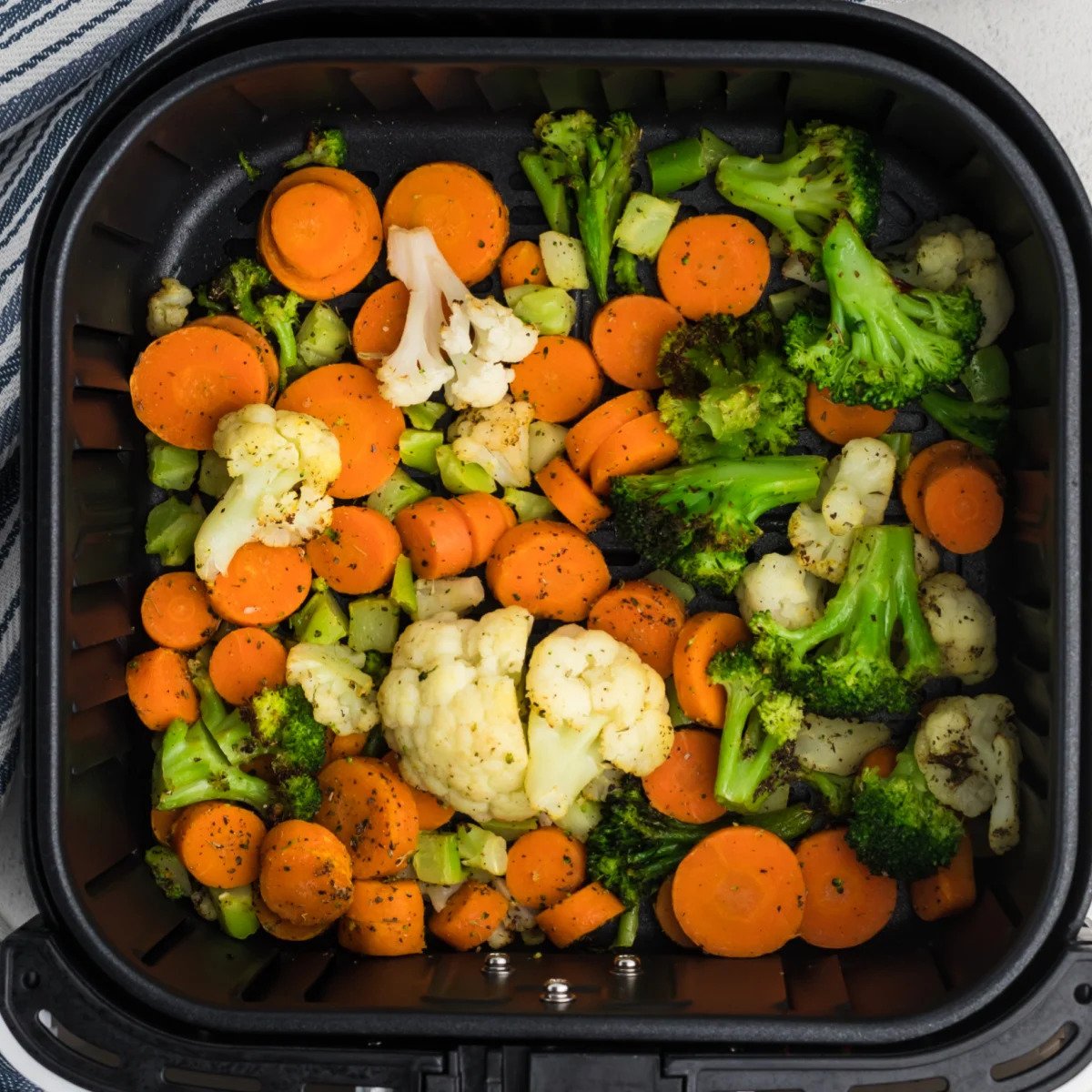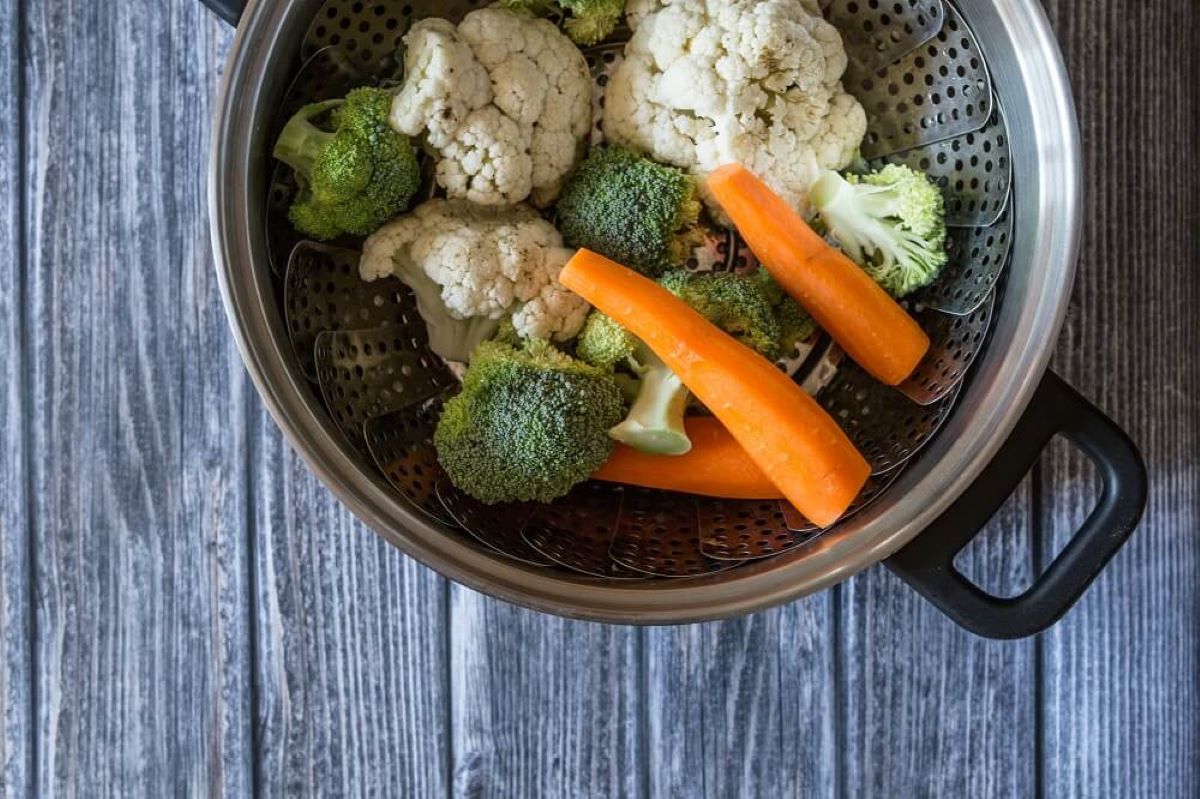Home>Gardening News and Trends>Latest News>How To Steam Cook Vegetables


Latest News
How To Steam Cook Vegetables
Modified: January 22, 2024
Discover the latest news on how to steam cook vegetables and enjoy a nutritious, flavorful meal. Follow our step-by-step guide for healthy cooking at home.
(Many of the links in this article redirect to a specific reviewed product. Your purchase of these products through affiliate links helps to generate commission for Chicagolandgardening.com, at no extra cost. Learn more)
Table of Contents
- Introduction
- Benefits of Steam Cooking Vegetables
- Choosing the Right Vegetables for Steaming
- Preparing the Vegetables for Steaming
- Equipment Needed for Steaming Vegetables
- Step-by-Step Guide to Steam Cooking Vegetables
- Testing the Doneness of Steamed Vegetables
- Seasoning and Serving Steamed Vegetables
- Tips and Tricks for Perfectly Steamed Vegetables
- Conclusion
Introduction
Steaming vegetables is an excellent way to maintain their nutritional value while enhancing their natural flavors. This gentle cooking method involves the use of steam to cook the vegetables, ensuring that they retain their vibrant colors, crisp texture, and essential nutrients. Whether you are a health-conscious individual looking to incorporate more vegetables into your diet or simply seeking a delicious way to enjoy your greens, steam cooking is a versatile and convenient option.
Unlike boiling, which can lead to nutrient loss due to prolonged exposure to high heat and water, steaming vegetables helps preserve their vitamins, minerals, and antioxidants. Additionally, steaming requires little to no oil, making it a healthier choice for those watching their calorie intake or following a low-fat diet. From broccoli and carrots to asparagus and cauliflower, almost any vegetable can be steamed to perfection, making it a suitable cooking method for a wide variety of produce.
In this article, we will explore the benefits of steam cooking vegetables, how to choose the right vegetables for steaming, the equipment needed, and a step-by-step guide on how to steam cook vegetables. We will also discuss ways to test the doneness of steamed vegetables, ideas for seasoning and serving, and share some expert tips and tricks for achieving perfectly steamed vegetables every time. By the end of this article, you will have all the knowledge you need to embrace the art of steam cooking and enjoy a nutritious and delicious array of vegetables.
Benefits of Steam Cooking Vegetables
Steam cooking vegetables offers numerous advantages that make it a preferred cooking method for those seeking to maintain the nutritional value of their produce. Here are some of the key benefits:
- Retained Nutrients: One of the main advantages of steam cooking vegetables is that it helps retain their natural nutrients. The gentle heat from steam preserves the water-soluble vitamins, such as vitamin C and B vitamins, which can be lost during traditional boiling methods.
- Minimal Nutrient Loss: Compared to other cooking methods, such as boiling or frying, steaming vegetables minimizes the loss of heat-sensitive nutrients. The water vapor from the steam surrounds the vegetables, ensuring that they cook evenly without being submerged in water for extended periods, helping to maintain their nutritional integrity.
- Enhanced Flavor and Texture: Steam cooking helps vegetables retain their natural flavors and textures. The gentle heat softens the vegetables while keeping them firm and crisp, providing a delightful mouthfeel.
- Preserves Vibrant Colors: Steaming vegetables helps preserve their vibrant colors, making them visually appealing on the plate. This not only adds to the aesthetics of a dish but also indicates that the vegetables are fresh and packed with nutrients.
- Quick and Convenient: Steam cooking is a quick and convenient method, allowing you to have a nutritious meal on the table in a short time. With simple preparation and minimal effort, you can enjoy perfectly cooked vegetables without any hassle.
- Healthier Cooking Option: Steam cooking vegetables requires little to no oil, making it a healthier cooking option. It is an excellent choice for individuals looking to reduce their calorie or fat intake while still enjoying delicious and nutrient-rich vegetables.
By steam cooking your vegetables, you can enjoy all the benefits of a nutrient-rich, flavorful, and visually appealing dish. Whether you are aiming to maintain a healthy diet or simply want to savor the natural goodness of vegetables, steaming is an excellent cooking method to try.
Choosing the Right Vegetables for Steaming
When it comes to steam cooking vegetables, not all vegetables are created equal. Some vegetables are better suited for steaming due to their texture and moisture content. Here are some guidelines to help you choose the right vegetables for steaming:
- Crisp and Firm Vegetables: Choose vegetables that are crisp and firm, as they will hold their shape better during the steaming process. Examples include broccoli, cauliflower, carrots, green beans, asparagus, Brussels sprouts, and snap peas.
- Leafy Greens: Leafy greens like spinach, kale, Swiss chard, and bok choy can also be steamed. However, keep in mind that leafy greens tend to wilt quickly, so they require less steaming time compared to firmer vegetables. Cook them just until they are wilted and bright green.
- Root Vegetables: Root vegetables, such as potatoes, sweet potatoes, beets, and turnips, can be steamed, but they may require slightly longer cooking times due to their denser texture. To ensure even cooking, it is recommended to cut them into smaller, uniform-sized pieces.
- Delicate Vegetables: Some delicate vegetables, such as zucchini, summer squash, and snow peas, can also be steamed. However, they have a higher water content and cook quickly, so keep a close eye on them to prevent overcooking.
- Avoid Overripe Vegetables: It’s important to choose vegetables that are fresh and in their prime. Avoid using overripe or mushy vegetables, as they may become overly soft and lose their texture when steamed.
Experiment with different vegetables to find your favorites. Combining different vegetables in a steamer basket can create a colorful and nutritious medley.
Keep in mind that the size and thickness of the vegetables will affect the cooking time. Cut larger vegetables into smaller, uniform-sized pieces to ensure they cook evenly.
By choosing the right vegetables for steaming, you can create delicious and vibrant dishes that retain the nutritional value and natural flavors of the vegetables.
Preparing the Vegetables for Steaming
Properly preparing the vegetables before steaming is essential to ensure even cooking and maximum flavor. Follow these steps to prepare your vegetables for steaming:
- Wash the Vegetables: Start by washing the vegetables thoroughly under cold running water. Use a vegetable brush to remove any dirt or debris, especially for root vegetables like potatoes and beets.
- Trim and Cut: Trim off any tough stems, ends, or blemishes from the vegetables. For vegetables like broccoli and cauliflower, cut them into florets of similar sizes, ensuring they are all approximately the same thickness. For carrots, green beans, and asparagus, trim off the ends.
- Uniform-sized Pieces: Cut the vegetables into uniform-sized pieces to ensure they cook evenly. This is particularly important when combining different vegetables in the same steaming session.
- Leave Some Skin: For vegetables like potatoes and sweet potatoes, leaving the skin on can help retain nutrients and provide a pleasant texture. Just make sure to scrub them well and remove any blemishes or eyes.
- Pierce Larger Vegetables: If you are steaming larger vegetables like potatoes or beets, it’s a good idea to pierce them with a fork or a knife. This will allow the steam to penetrate the vegetables more easily, ensuring they cook evenly.
Remember, the goal is to have vegetables of similar size and thickness to promote even cooking. Take the time to prepare the vegetables properly, and you’ll be rewarded with perfectly steamed vegetables that are both visually appealing and delicious.
Equipment Needed for Steaming Vegetables
Steaming vegetables is a straightforward cooking method that requires minimal equipment. Here are the essential tools you’ll need to steam vegetables:
- Steamer Basket: A steamer basket is a versatile and indispensable tool for steaming vegetables. It allows the steam to circulate around the vegetables, ensuring even cooking. There are various types of steamer baskets available, including stainless steel, collapsible silicone, or bamboo. Choose one that fits comfortably in your saucepan or pot.
- Saucepan or Pot: You’ll need a saucepan or pot large enough to accommodate the steamer basket. Make sure the pot has a tight-fitting lid to trap the steam effectively.
- Water: Steaming vegetables requires water to generate steam. Fill the saucepan or pot with enough water to create steam but not so much that it touches the bottom of the steamer basket. Around one inch of water is typically sufficient.
- Tongs or a Fork: Use tongs or a fork to handle the hot steamer basket and transfer the steamed vegetables to a serving dish.
- Optional Enhancements: While not essential, some steamers come with additional features such as a built-in timer or multiple tiers to steam different vegetables simultaneously. These can be helpful if you frequently steam vegetables and want to streamline the cooking process.
It’s worth noting that if you don’t have a steamer basket, you can also use other kitchen tools to achieve similar results. For example, a heatproof colander or a stainless steel sieve can be placed on top of a pot with a few inches of boiling water, creating a makeshift steamer.
With just a few basic pieces of equipment, you’ll be well-equipped to start steaming vegetables to perfection.
Step-by-Step Guide to Steam Cooking Vegetables
Steaming vegetables is a straightforward process that yields delicious and nutritious results. Follow these simple steps to steam cook vegetables:
- Prepare the Steamer: Fill a saucepan or pot with about an inch of water. Place the steamer basket inside the pot, ensuring it sits above the water level.
- Prepare the Vegetables: Wash, trim, and cut the vegetables as needed. Ensure the vegetables are of uniform size and thickness for even cooking.
- Bring the Water to a Boil: Place the saucepan or pot on the stove over medium to high heat. Cover the pot with a lid and bring the water to a rolling boil.
- Add the Vegetables: Once the water is boiling, carefully place the prepared vegetables in the steamer basket. Arrange them in a single layer, making sure not to overcrowd the basket. If you have different vegetables with varying cooking times, you can stagger their addition or use a multi-tiered steamer.
- Cover and Steam: Cover the pot with the lid to trap the steam. Allow the vegetables to steam for the recommended cooking time, typically 3-8 minutes, depending on the vegetable’s size and desired tenderness. Avoid opening the lid frequently, as this will result in heat loss and may increase the cooking time.
- Check for Doneness: Test the doneness of the vegetables by piercing them with a fork or tasting a piece. The vegetables should be tender but still retain their crispness. If they are not cooked to your liking, cover the pot and continue steaming for a few more minutes.
- Transfer and Serve: Once the vegetables are cooked to perfection, use tongs or a fork to carefully remove them from the steamer basket. Transfer them to a serving dish or plate and season with your choice of herbs, spices, or sauces.
Steamed vegetables are versatile and can be enjoyed as a side dish, added to salads, stir-fries, or used as toppings for grain bowls. Serve them hot or cold, depending on your preference.
With this step-by-step guide, you can easily steam cook a variety of vegetables to retain their nutrients and natural flavors.
Testing the Doneness of Steamed Vegetables
Properly determining the doneness of steamed vegetables is crucial to achieving the desired texture and flavor. Here are some methods you can use to test whether your vegetables are cooked to perfection:
- Fork Test: Use a fork to pierce the vegetables. If the fork goes through easily and the vegetables are tender, they are likely done. However, be careful not to overcook them as they may become mushy.
- Taste Test: Take a small bite of a vegetable piece to assess its texture and tenderness. The vegetables should be cooked but still have a slight crispness or firmness, depending on your preference.
- Color and Texture: Visual cues can also help determine doneness. Steamed vegetables should be vibrant in color and have a tender yet slightly crunchy texture. Avoid overcooking, as this can result in dull-colored and soggy vegetables.
- Timings and Recipes: Follow recommended cooking times and recipes as a general guideline. Keep in mind that cooking times can vary based on the size and type of vegetable. Adjust the cooking time accordingly until you achieve your desired doneness.
- Experience: With practice, you will develop a sense of doneness by the color, texture, and cooking times of various vegetables. Trust your instincts and adjust the cooking time accordingly based on your preference and previous experiences.
Remember that vegetables will continue to cook slightly even after being removed from the heat, so it’s better to slightly undercook them if you prefer a firmer texture.
By using these methods, you can confidently determine if your steamed vegetables are cooked to perfection and enjoy them at their best.
Seasoning and Serving Steamed Vegetables
While steamed vegetables are delicious on their own, adding some seasonings and serving them with complementary ingredients can elevate their flavor and make them even more enticing. Here are some ideas for seasoning and serving steamed vegetables:
- Simple Seasonings: Enhance the natural flavors of steamed vegetables with simple seasonings such as sea salt, black pepper, garlic powder, or lemon juice. These basic seasonings allow the flavors of the vegetables to shine without overpowering them.
- Herbs and Spices: Experiment with a variety of fresh or dried herbs and spices to add depth and complexity to your steamed vegetables. Some popular options include rosemary, thyme, basil, oregano, cumin, paprika, or curry powder. Toss the steamed vegetables with your chosen herbs and spices for an aromatic twist.
- Sauces and Dressings: Drizzling your steamed vegetables with a flavorful sauce or dressing can utterly transform their taste. Options like tahini sauce, soy ginger dressing, balsamic glaze, or homemade vinaigrettes can add a burst of flavor and moisture.
- Grated Cheese: For a creamy and indulgent touch, top your steamed vegetables with a sprinkle of grated cheese. Parmesan, feta, cheddar, or goat cheese can add a savory element that pairs well with a wide range of vegetables.
- Nuts and Seeds: Toasted nuts and seeds add a delightful crunch and nutty flavor to steamed vegetables. Sprinkle some almonds, walnuts, sesame seeds, or pumpkin seeds over the vegetables for an extra textural element.
- Combining with Other Ingredients: Mix your steamed vegetables with other ingredients to create versatile dishes. For example, you can toss steamed broccoli with cooked pasta and olive oil or sautéed garlic for a quick and healthy pasta dish. Or combine steamed asparagus with cherry tomatoes and feta cheese for a vibrant salad.
When serving steamed vegetables, consider presentation. Arrange them artfully on a platter or plate, garnish with fresh herbs or a drizzle of sauce, and add a sprinkle of salt or pepper on top. This not only enhances the visual appeal but also adds an additional layer of flavor.
Feel free to get creative and experiment with different flavors and combinations to find your favorite way of seasoning and serving steamed vegetables. The possibilities are endless!
Tips and Tricks for Perfectly Steamed Vegetables
To achieve perfectly steamed vegetables every time, consider these helpful tips and tricks:
- Timing is Key: Different vegetables have varying cooking times. To ensure all the vegetables are cooked evenly, start with the vegetables that require a longer cooking time and add the quicker-cooking vegetables later.
- Steaming Time: Steaming vegetables until they are just tender, with a slight crunch, will help retain their nutritional value and vibrant colors. Be cautious not to overcook them, as they can become mushy and lose their appeal.
- Don’t Overcrowd the Steamer Basket: Overcrowding the steamer basket can lead to uneven cooking. Leave enough space between the vegetable pieces to allow steam to circulate freely.
- Keep an Eye on the Water Level: Ensure there is enough water in the pot to generate steam throughout the cooking process. If the water level gets too low, add more hot water to maintain the steam.
- Undercook Slightly: Account for residual heat by slightly undercooking the vegetables. They will continue to cook once removed from the steamer basket, and this will help prevent overcooking.
- Preserve Nutrients: To minimize nutrient loss, use a steamer basket instead of boiling vegetables in water. Steaming helps retain vital vitamins and minerals that can be lost in boiling water.
- Save the Steaming Liquid: The water used to steam vegetables contains valuable nutrients. Consider using it in soups, broths, or sauces to maximize the nutritional benefits.
- Experiment with Flavors: Don’t be afraid to experiment with different seasonings, herbs, and spices to add an extra layer of flavor to your steamed vegetables. Be bold and try new combinations to find your favorite flavor profiles.
- Enjoy Leftovers: Steamed vegetables can be refrigerated and enjoyed as leftovers. They make a nutritious addition to salads, sandwiches, stir-fries, or can be reheated as a side dish for future meals.
- Use High-Quality Vegetables: Fresh, high-quality vegetables will yield the best results when steaming. Choose vegetables that are in season and visually appealing to ensure the tastiest outcome.
By following these tips and tricks, you can achieve perfectly steamed vegetables that are flavorful, nutritious, and visually appealing, adding a healthy and delicious component to any meal.
Conclusion
Steaming vegetables is a simple and effective cooking method that allows you to retain the nutritional value, vibrant colors, and natural flavors of your favorite greens. By using minimal equipment and following a few easy steps, you can enjoy perfectly steamed vegetables that are delicious, healthy, and versatile.
Throughout this article, we discussed the benefits of steam cooking vegetables, the importance of choosing the right vegetables for steaming, and how to prepare them for the process. We also explored the necessary equipment and provided a step-by-step guide to steam cooking vegetables. Additionally, we shared tips and tricks to help you achieve perfectly steamed vegetables every time.
Steamed vegetables can be enjoyed in various ways – from simple seasonings like salt, pepper, and lemon juice to more complex flavors created with herbs, spices, sauces, or grated cheese. You can also incorporate steamed vegetables into a range of dishes or enjoy them as a refreshing side dish or salad. The possibilities are endless.
By embracing the art of steam cooking, you can indulge in healthy and delicious meals that showcase the natural goodness of vegetables. So, grab your steamer basket, choose your favorite vegetables, and start steaming your way to flavorful and nutrient-rich dishes. Your taste buds and body will thank you!










